Project Management: London School of Business Charity Event
VerifiedAdded on 2019/12/18
|12
|3243
|301
Project
AI Summary
This project management assignment details a plan for a one-day charity fundraising event organized by the London School of Business and Management to celebrate the end of the academic year and raise funds for charity. The project scope includes defining objectives, deliverables, milestones, and technical requirements, while also establishing priorities. The assignment covers project cost management, including resource analysis and budgeting, and time management, which includes a Gantt chart, network diagram, and critical path analysis. Risk management is also addressed, with risk identification, analysis, and a risk matrix. The project charter outlines the business case, goal statement, scope, team members, and timelines. The budget estimates costs for various event activities, and the project aims to raise at least £2017. The plan also includes a detailed Gantt chart, network diagram and critical path analysis to outline the project's timeline.

Project Management
1
1
Paraphrase This Document
Need a fresh take? Get an instant paraphrase of this document with our AI Paraphraser
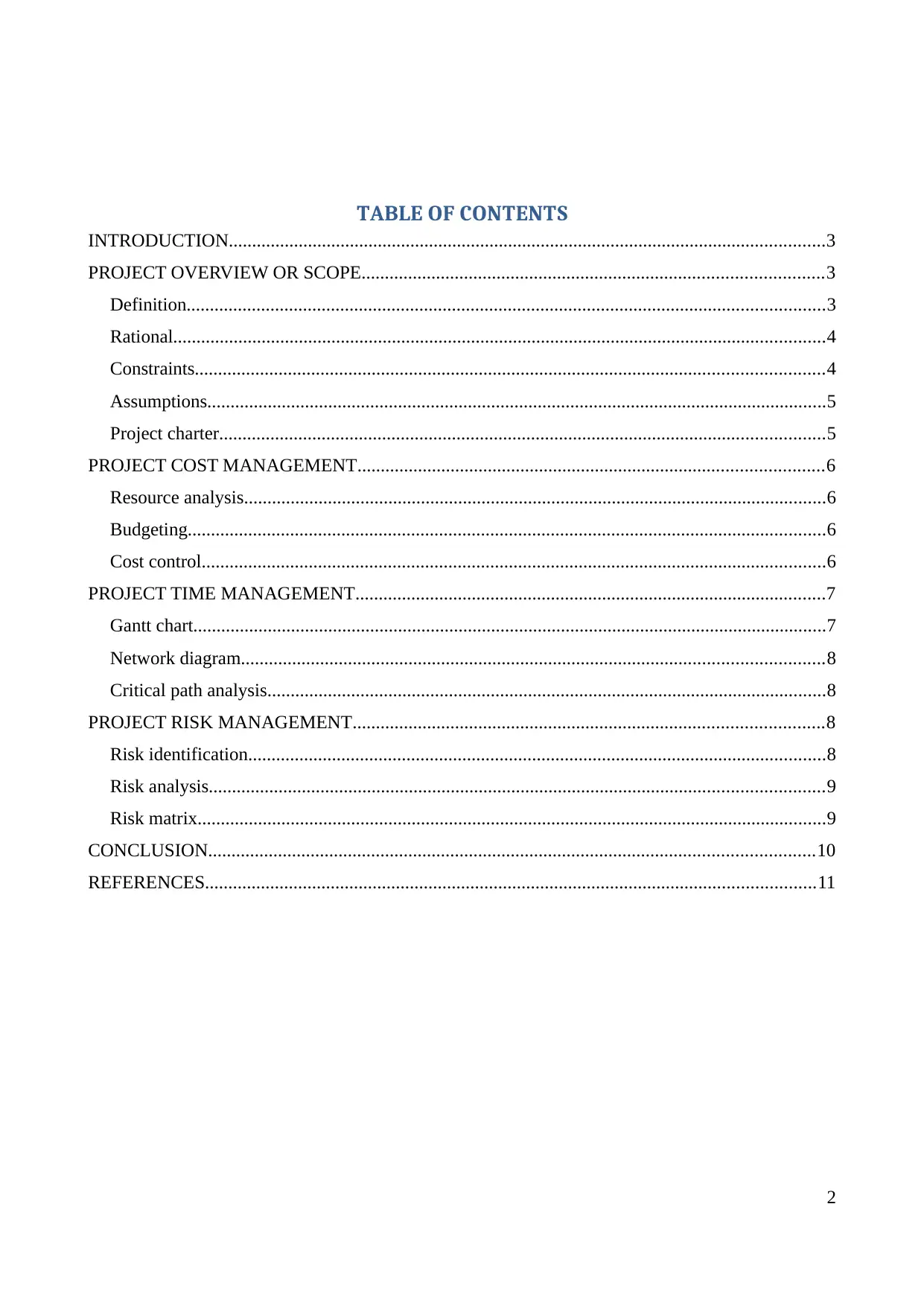
TABLE OF CONTENTS
INTRODUCTION................................................................................................................................3
PROJECT OVERVIEW OR SCOPE...................................................................................................3
Definition.........................................................................................................................................3
Rational............................................................................................................................................4
Constraints.......................................................................................................................................4
Assumptions.....................................................................................................................................5
Project charter..................................................................................................................................5
PROJECT COST MANAGEMENT....................................................................................................6
Resource analysis.............................................................................................................................6
Budgeting.........................................................................................................................................6
Cost control......................................................................................................................................6
PROJECT TIME MANAGEMENT.....................................................................................................7
Gantt chart........................................................................................................................................7
Network diagram.............................................................................................................................8
Critical path analysis........................................................................................................................8
PROJECT RISK MANAGEMENT.....................................................................................................8
Risk identification............................................................................................................................8
Risk analysis....................................................................................................................................9
Risk matrix.......................................................................................................................................9
CONCLUSION..................................................................................................................................10
REFERENCES...................................................................................................................................11
2
INTRODUCTION................................................................................................................................3
PROJECT OVERVIEW OR SCOPE...................................................................................................3
Definition.........................................................................................................................................3
Rational............................................................................................................................................4
Constraints.......................................................................................................................................4
Assumptions.....................................................................................................................................5
Project charter..................................................................................................................................5
PROJECT COST MANAGEMENT....................................................................................................6
Resource analysis.............................................................................................................................6
Budgeting.........................................................................................................................................6
Cost control......................................................................................................................................6
PROJECT TIME MANAGEMENT.....................................................................................................7
Gantt chart........................................................................................................................................7
Network diagram.............................................................................................................................8
Critical path analysis........................................................................................................................8
PROJECT RISK MANAGEMENT.....................................................................................................8
Risk identification............................................................................................................................8
Risk analysis....................................................................................................................................9
Risk matrix.......................................................................................................................................9
CONCLUSION..................................................................................................................................10
REFERENCES...................................................................................................................................11
2
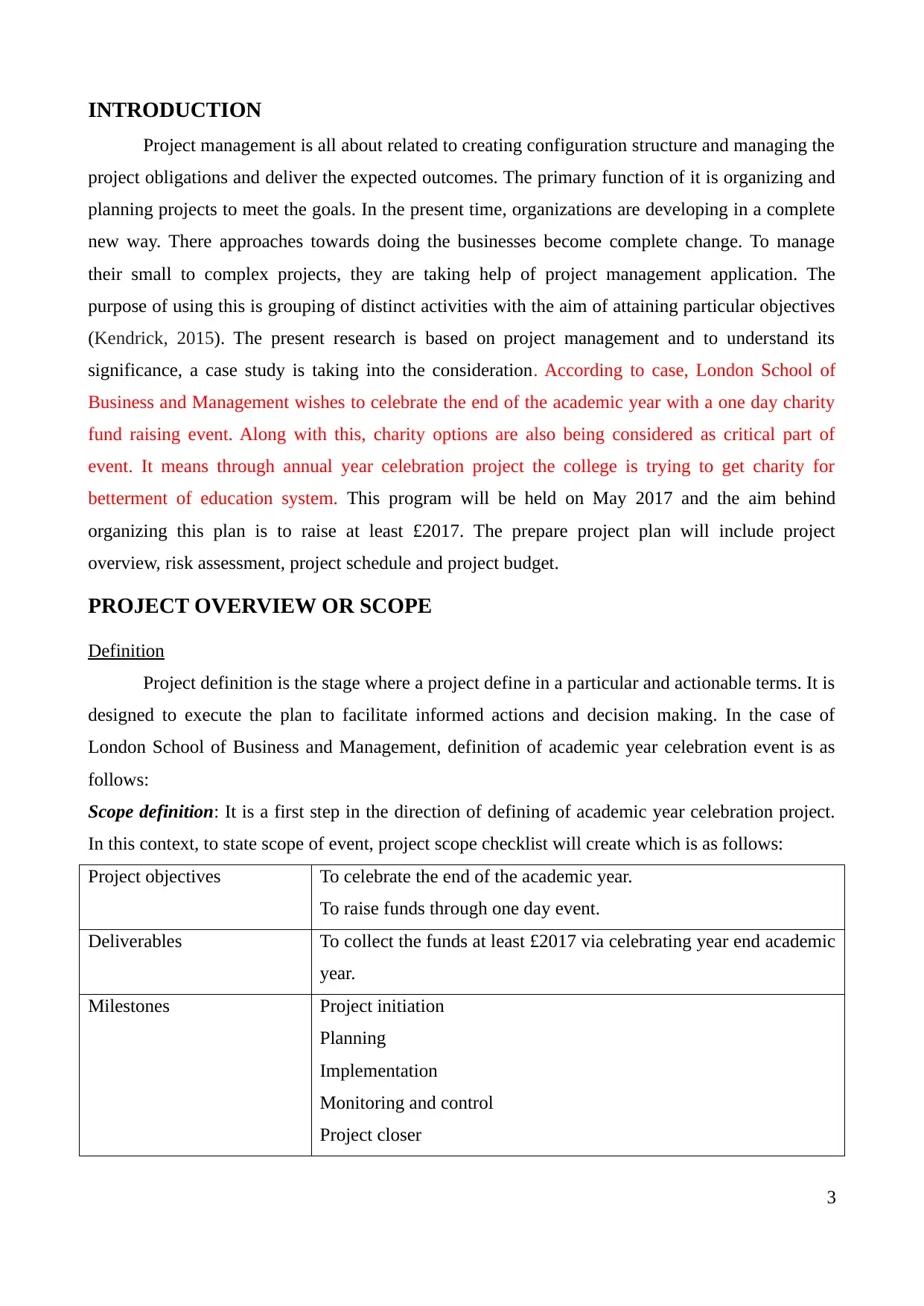
INTRODUCTION
Project management is all about related to creating configuration structure and managing the
project obligations and deliver the expected outcomes. The primary function of it is organizing and
planning projects to meet the goals. In the present time, organizations are developing in a complete
new way. There approaches towards doing the businesses become complete change. To manage
their small to complex projects, they are taking help of project management application. The
purpose of using this is grouping of distinct activities with the aim of attaining particular objectives
(Kendrick, 2015). The present research is based on project management and to understand its
significance, a case study is taking into the consideration. According to case, London School of
Business and Management wishes to celebrate the end of the academic year with a one day charity
fund raising event. Along with this, charity options are also being considered as critical part of
event. It means through annual year celebration project the college is trying to get charity for
betterment of education system. This program will be held on May 2017 and the aim behind
organizing this plan is to raise at least £2017. The prepare project plan will include project
overview, risk assessment, project schedule and project budget.
PROJECT OVERVIEW OR SCOPE
Definition
Project definition is the stage where a project define in a particular and actionable terms. It is
designed to execute the plan to facilitate informed actions and decision making. In the case of
London School of Business and Management, definition of academic year celebration event is as
follows:
Scope definition: It is a first step in the direction of defining of academic year celebration project.
In this context, to state scope of event, project scope checklist will create which is as follows:
Project objectives To celebrate the end of the academic year.
To raise funds through one day event.
Deliverables To collect the funds at least £2017 via celebrating year end academic
year.
Milestones Project initiation
Planning
Implementation
Monitoring and control
Project closer
3
Project management is all about related to creating configuration structure and managing the
project obligations and deliver the expected outcomes. The primary function of it is organizing and
planning projects to meet the goals. In the present time, organizations are developing in a complete
new way. There approaches towards doing the businesses become complete change. To manage
their small to complex projects, they are taking help of project management application. The
purpose of using this is grouping of distinct activities with the aim of attaining particular objectives
(Kendrick, 2015). The present research is based on project management and to understand its
significance, a case study is taking into the consideration. According to case, London School of
Business and Management wishes to celebrate the end of the academic year with a one day charity
fund raising event. Along with this, charity options are also being considered as critical part of
event. It means through annual year celebration project the college is trying to get charity for
betterment of education system. This program will be held on May 2017 and the aim behind
organizing this plan is to raise at least £2017. The prepare project plan will include project
overview, risk assessment, project schedule and project budget.
PROJECT OVERVIEW OR SCOPE
Definition
Project definition is the stage where a project define in a particular and actionable terms. It is
designed to execute the plan to facilitate informed actions and decision making. In the case of
London School of Business and Management, definition of academic year celebration event is as
follows:
Scope definition: It is a first step in the direction of defining of academic year celebration project.
In this context, to state scope of event, project scope checklist will create which is as follows:
Project objectives To celebrate the end of the academic year.
To raise funds through one day event.
Deliverables To collect the funds at least £2017 via celebrating year end academic
year.
Milestones Project initiation
Planning
Implementation
Monitoring and control
Project closer
3
⊘ This is a preview!⊘
Do you want full access?
Subscribe today to unlock all pages.

Trusted by 1+ million students worldwide
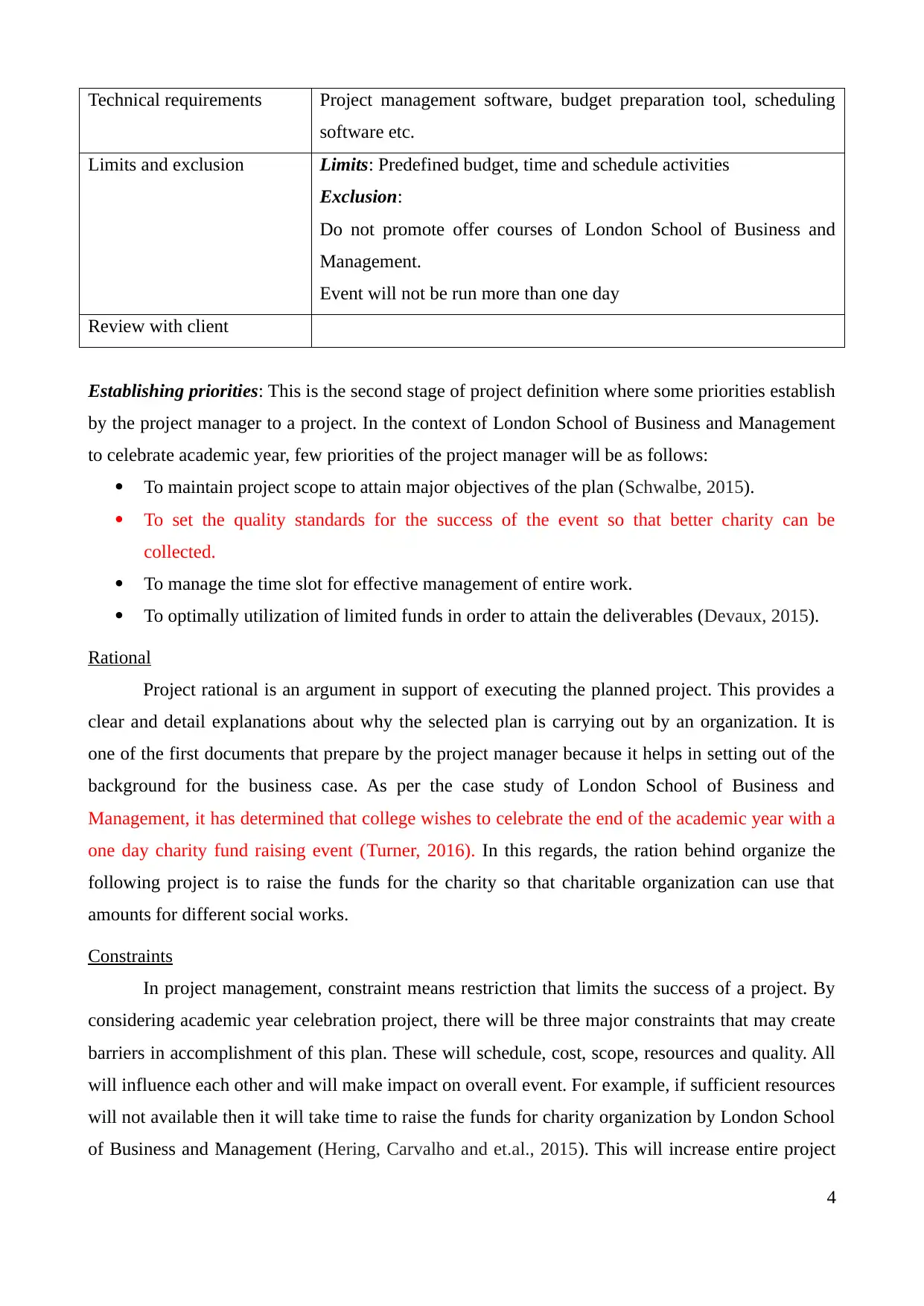
Technical requirements Project management software, budget preparation tool, scheduling
software etc.
Limits and exclusion Limits: Predefined budget, time and schedule activities
Exclusion:
Do not promote offer courses of London School of Business and
Management.
Event will not be run more than one day
Review with client
Establishing priorities: This is the second stage of project definition where some priorities establish
by the project manager to a project. In the context of London School of Business and Management
to celebrate academic year, few priorities of the project manager will be as follows:
To maintain project scope to attain major objectives of the plan (Schwalbe, 2015).
To set the quality standards for the success of the event so that better charity can be
collected.
To manage the time slot for effective management of entire work.
To optimally utilization of limited funds in order to attain the deliverables (Devaux, 2015).
Rational
Project rational is an argument in support of executing the planned project. This provides a
clear and detail explanations about why the selected plan is carrying out by an organization. It is
one of the first documents that prepare by the project manager because it helps in setting out of the
background for the business case. As per the case study of London School of Business and
Management, it has determined that college wishes to celebrate the end of the academic year with a
one day charity fund raising event (Turner, 2016). In this regards, the ration behind organize the
following project is to raise the funds for the charity so that charitable organization can use that
amounts for different social works.
Constraints
In project management, constraint means restriction that limits the success of a project. By
considering academic year celebration project, there will be three major constraints that may create
barriers in accomplishment of this plan. These will schedule, cost, scope, resources and quality. All
will influence each other and will make impact on overall event. For example, if sufficient resources
will not available then it will take time to raise the funds for charity organization by London School
of Business and Management (Hering, Carvalho and et.al., 2015). This will increase entire project
4
software etc.
Limits and exclusion Limits: Predefined budget, time and schedule activities
Exclusion:
Do not promote offer courses of London School of Business and
Management.
Event will not be run more than one day
Review with client
Establishing priorities: This is the second stage of project definition where some priorities establish
by the project manager to a project. In the context of London School of Business and Management
to celebrate academic year, few priorities of the project manager will be as follows:
To maintain project scope to attain major objectives of the plan (Schwalbe, 2015).
To set the quality standards for the success of the event so that better charity can be
collected.
To manage the time slot for effective management of entire work.
To optimally utilization of limited funds in order to attain the deliverables (Devaux, 2015).
Rational
Project rational is an argument in support of executing the planned project. This provides a
clear and detail explanations about why the selected plan is carrying out by an organization. It is
one of the first documents that prepare by the project manager because it helps in setting out of the
background for the business case. As per the case study of London School of Business and
Management, it has determined that college wishes to celebrate the end of the academic year with a
one day charity fund raising event (Turner, 2016). In this regards, the ration behind organize the
following project is to raise the funds for the charity so that charitable organization can use that
amounts for different social works.
Constraints
In project management, constraint means restriction that limits the success of a project. By
considering academic year celebration project, there will be three major constraints that may create
barriers in accomplishment of this plan. These will schedule, cost, scope, resources and quality. All
will influence each other and will make impact on overall event. For example, if sufficient resources
will not available then it will take time to raise the funds for charity organization by London School
of Business and Management (Hering, Carvalho and et.al., 2015). This will increase entire project
4
Paraphrase This Document
Need a fresh take? Get an instant paraphrase of this document with our AI Paraphraser
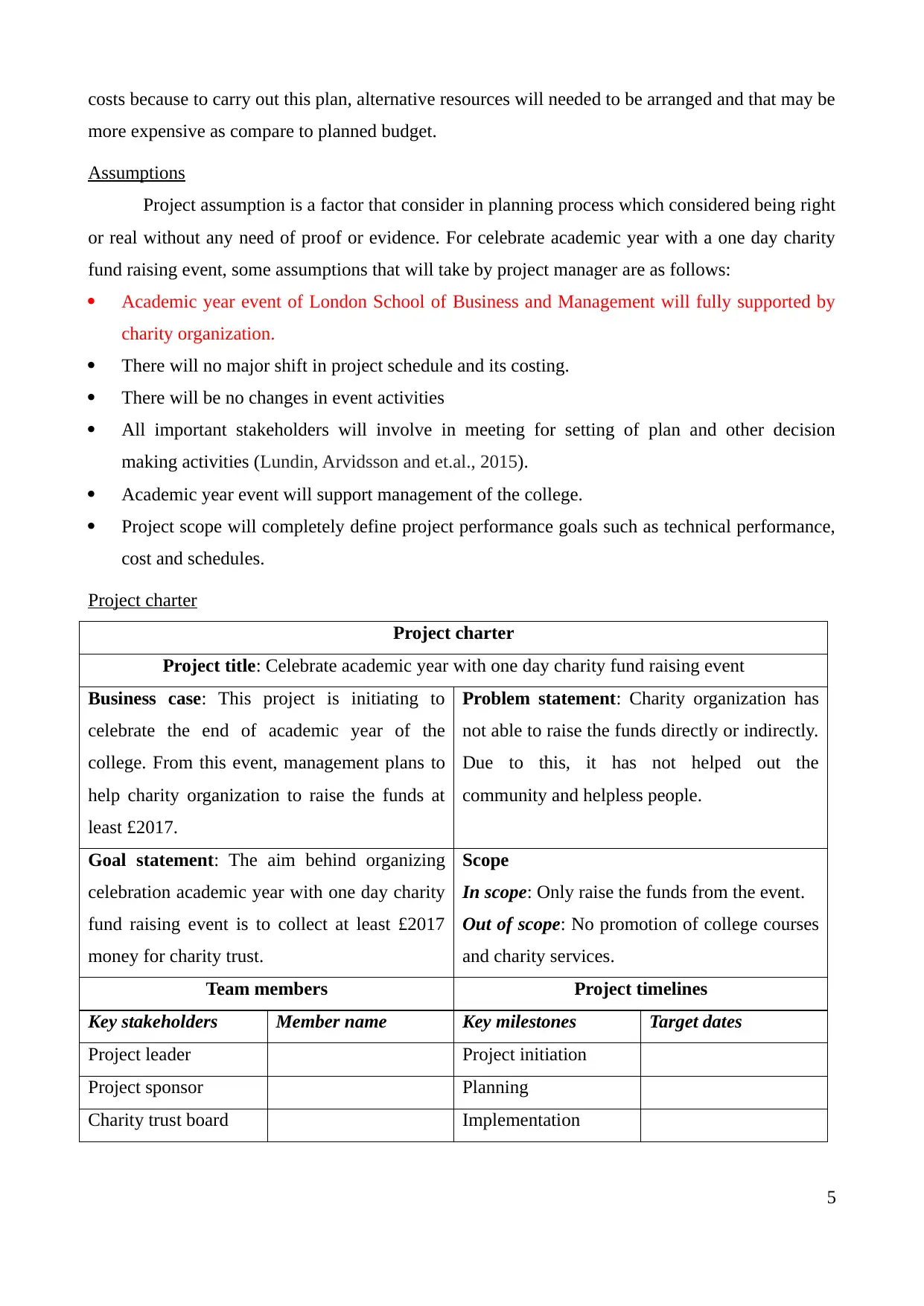
costs because to carry out this plan, alternative resources will needed to be arranged and that may be
more expensive as compare to planned budget.
Assumptions
Project assumption is a factor that consider in planning process which considered being right
or real without any need of proof or evidence. For celebrate academic year with a one day charity
fund raising event, some assumptions that will take by project manager are as follows:
Academic year event of London School of Business and Management will fully supported by
charity organization.
There will no major shift in project schedule and its costing.
There will be no changes in event activities
All important stakeholders will involve in meeting for setting of plan and other decision
making activities (Lundin, Arvidsson and et.al., 2015).
Academic year event will support management of the college.
Project scope will completely define project performance goals such as technical performance,
cost and schedules.
Project charter
Project charter
Project title: Celebrate academic year with one day charity fund raising event
Business case: This project is initiating to
celebrate the end of academic year of the
college. From this event, management plans to
help charity organization to raise the funds at
least £2017.
Problem statement: Charity organization has
not able to raise the funds directly or indirectly.
Due to this, it has not helped out the
community and helpless people.
Goal statement: The aim behind organizing
celebration academic year with one day charity
fund raising event is to collect at least £2017
money for charity trust.
Scope
In scope: Only raise the funds from the event.
Out of scope: No promotion of college courses
and charity services.
Team members Project timelines
Key stakeholders Member name Key milestones Target dates
Project leader Project initiation
Project sponsor Planning
Charity trust board Implementation
5
more expensive as compare to planned budget.
Assumptions
Project assumption is a factor that consider in planning process which considered being right
or real without any need of proof or evidence. For celebrate academic year with a one day charity
fund raising event, some assumptions that will take by project manager are as follows:
Academic year event of London School of Business and Management will fully supported by
charity organization.
There will no major shift in project schedule and its costing.
There will be no changes in event activities
All important stakeholders will involve in meeting for setting of plan and other decision
making activities (Lundin, Arvidsson and et.al., 2015).
Academic year event will support management of the college.
Project scope will completely define project performance goals such as technical performance,
cost and schedules.
Project charter
Project charter
Project title: Celebrate academic year with one day charity fund raising event
Business case: This project is initiating to
celebrate the end of academic year of the
college. From this event, management plans to
help charity organization to raise the funds at
least £2017.
Problem statement: Charity organization has
not able to raise the funds directly or indirectly.
Due to this, it has not helped out the
community and helpless people.
Goal statement: The aim behind organizing
celebration academic year with one day charity
fund raising event is to collect at least £2017
money for charity trust.
Scope
In scope: Only raise the funds from the event.
Out of scope: No promotion of college courses
and charity services.
Team members Project timelines
Key stakeholders Member name Key milestones Target dates
Project leader Project initiation
Project sponsor Planning
Charity trust board Implementation
5
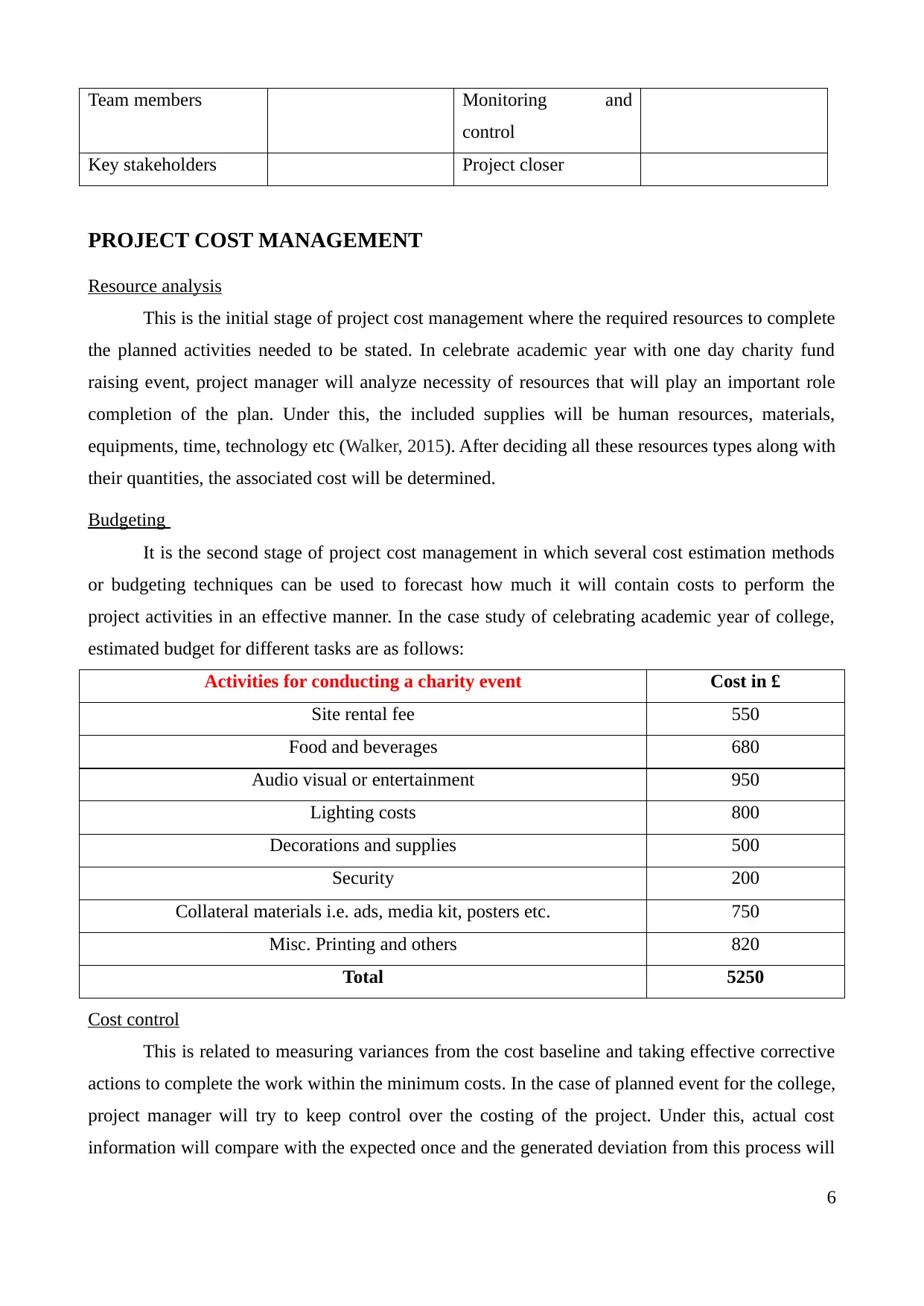
Team members Monitoring and
control
Key stakeholders Project closer
PROJECT COST MANAGEMENT
Resource analysis
This is the initial stage of project cost management where the required resources to complete
the planned activities needed to be stated. In celebrate academic year with one day charity fund
raising event, project manager will analyze necessity of resources that will play an important role
completion of the plan. Under this, the included supplies will be human resources, materials,
equipments, time, technology etc (Walker, 2015). After deciding all these resources types along with
their quantities, the associated cost will be determined.
Budgeting
It is the second stage of project cost management in which several cost estimation methods
or budgeting techniques can be used to forecast how much it will contain costs to perform the
project activities in an effective manner. In the case study of celebrating academic year of college,
estimated budget for different tasks are as follows:
Activities for conducting a charity event Cost in £
Site rental fee 550
Food and beverages 680
Audio visual or entertainment 950
Lighting costs 800
Decorations and supplies 500
Security 200
Collateral materials i.e. ads, media kit, posters etc. 750
Misc. Printing and others 820
Total 5250
Cost control
This is related to measuring variances from the cost baseline and taking effective corrective
actions to complete the work within the minimum costs. In the case of planned event for the college,
project manager will try to keep control over the costing of the project. Under this, actual cost
information will compare with the expected once and the generated deviation from this process will
6
control
Key stakeholders Project closer
PROJECT COST MANAGEMENT
Resource analysis
This is the initial stage of project cost management where the required resources to complete
the planned activities needed to be stated. In celebrate academic year with one day charity fund
raising event, project manager will analyze necessity of resources that will play an important role
completion of the plan. Under this, the included supplies will be human resources, materials,
equipments, time, technology etc (Walker, 2015). After deciding all these resources types along with
their quantities, the associated cost will be determined.
Budgeting
It is the second stage of project cost management in which several cost estimation methods
or budgeting techniques can be used to forecast how much it will contain costs to perform the
project activities in an effective manner. In the case study of celebrating academic year of college,
estimated budget for different tasks are as follows:
Activities for conducting a charity event Cost in £
Site rental fee 550
Food and beverages 680
Audio visual or entertainment 950
Lighting costs 800
Decorations and supplies 500
Security 200
Collateral materials i.e. ads, media kit, posters etc. 750
Misc. Printing and others 820
Total 5250
Cost control
This is related to measuring variances from the cost baseline and taking effective corrective
actions to complete the work within the minimum costs. In the case of planned event for the college,
project manager will try to keep control over the costing of the project. Under this, actual cost
information will compare with the expected once and the generated deviation from this process will
6
⊘ This is a preview!⊘
Do you want full access?
Subscribe today to unlock all pages.

Trusted by 1+ million students worldwide
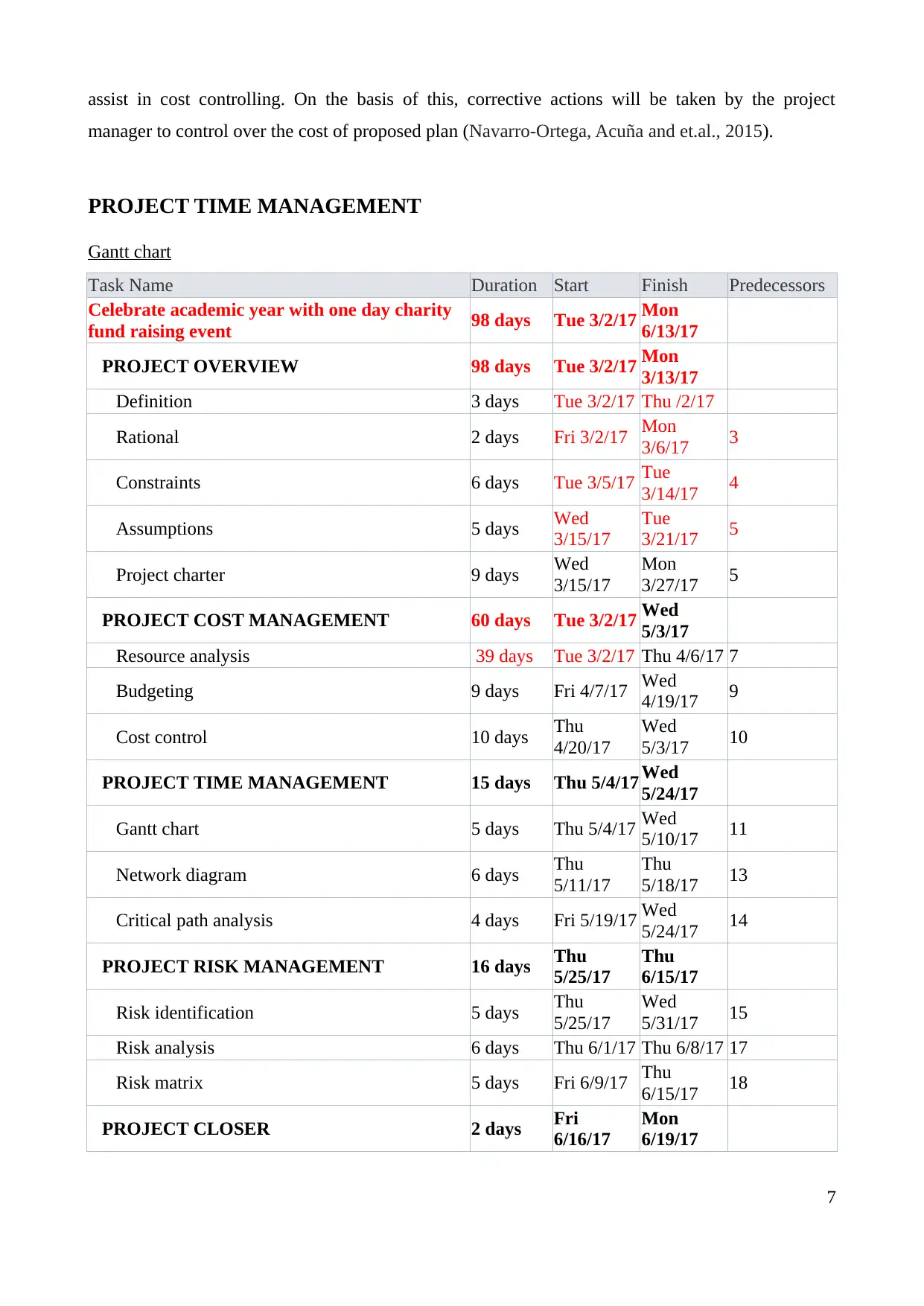
assist in cost controlling. On the basis of this, corrective actions will be taken by the project
manager to control over the cost of proposed plan (Navarro-Ortega, Acuña and et.al., 2015).
PROJECT TIME MANAGEMENT
Gantt chart
Task Name Duration Start Finish Predecessors
Celebrate academic year with one day charity
fund raising event 98 days Tue 3/2/17 Mon
6/13/17
PROJECT OVERVIEW 98 days Tue 3/2/17 Mon
3/13/17
Definition 3 days Tue 3/2/17 Thu /2/17
Rational 2 days Fri 3/2/17 Mon
3/6/17 3
Constraints 6 days Tue 3/5/17 Tue
3/14/17 4
Assumptions 5 days Wed
3/15/17
Tue
3/21/17 5
Project charter 9 days Wed
3/15/17
Mon
3/27/17 5
PROJECT COST MANAGEMENT 60 days Tue 3/2/17 Wed
5/3/17
Resource analysis 39 days Tue 3/2/17 Thu 4/6/17 7
Budgeting 9 days Fri 4/7/17 Wed
4/19/17 9
Cost control 10 days Thu
4/20/17
Wed
5/3/17 10
PROJECT TIME MANAGEMENT 15 days Thu 5/4/17 Wed
5/24/17
Gantt chart 5 days Thu 5/4/17 Wed
5/10/17 11
Network diagram 6 days Thu
5/11/17
Thu
5/18/17 13
Critical path analysis 4 days Fri 5/19/17 Wed
5/24/17 14
PROJECT RISK MANAGEMENT 16 days Thu
5/25/17
Thu
6/15/17
Risk identification 5 days Thu
5/25/17
Wed
5/31/17 15
Risk analysis 6 days Thu 6/1/17 Thu 6/8/17 17
Risk matrix 5 days Fri 6/9/17 Thu
6/15/17 18
PROJECT CLOSER 2 days Fri
6/16/17
Mon
6/19/17
7
manager to control over the cost of proposed plan (Navarro-Ortega, Acuña and et.al., 2015).
PROJECT TIME MANAGEMENT
Gantt chart
Task Name Duration Start Finish Predecessors
Celebrate academic year with one day charity
fund raising event 98 days Tue 3/2/17 Mon
6/13/17
PROJECT OVERVIEW 98 days Tue 3/2/17 Mon
3/13/17
Definition 3 days Tue 3/2/17 Thu /2/17
Rational 2 days Fri 3/2/17 Mon
3/6/17 3
Constraints 6 days Tue 3/5/17 Tue
3/14/17 4
Assumptions 5 days Wed
3/15/17
Tue
3/21/17 5
Project charter 9 days Wed
3/15/17
Mon
3/27/17 5
PROJECT COST MANAGEMENT 60 days Tue 3/2/17 Wed
5/3/17
Resource analysis 39 days Tue 3/2/17 Thu 4/6/17 7
Budgeting 9 days Fri 4/7/17 Wed
4/19/17 9
Cost control 10 days Thu
4/20/17
Wed
5/3/17 10
PROJECT TIME MANAGEMENT 15 days Thu 5/4/17 Wed
5/24/17
Gantt chart 5 days Thu 5/4/17 Wed
5/10/17 11
Network diagram 6 days Thu
5/11/17
Thu
5/18/17 13
Critical path analysis 4 days Fri 5/19/17 Wed
5/24/17 14
PROJECT RISK MANAGEMENT 16 days Thu
5/25/17
Thu
6/15/17
Risk identification 5 days Thu
5/25/17
Wed
5/31/17 15
Risk analysis 6 days Thu 6/1/17 Thu 6/8/17 17
Risk matrix 5 days Fri 6/9/17 Thu
6/15/17 18
PROJECT CLOSER 2 days Fri
6/16/17
Mon
6/19/17
7
Paraphrase This Document
Need a fresh take? Get an instant paraphrase of this document with our AI Paraphraser
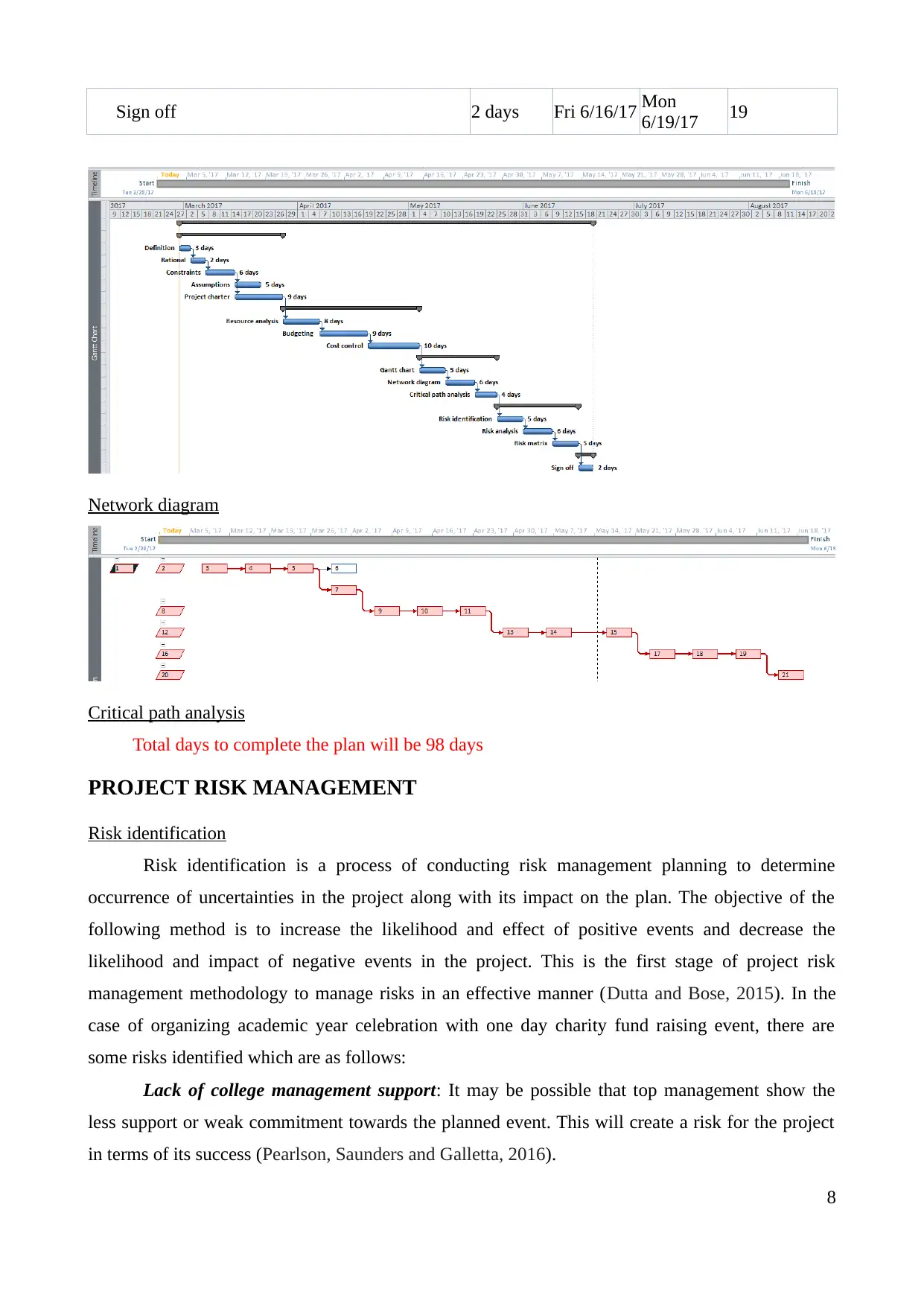
Sign off 2 days Fri 6/16/17 Mon
6/19/17 19
Network diagram
Critical path analysis
Total days to complete the plan will be 98 days
PROJECT RISK MANAGEMENT
Risk identification
Risk identification is a process of conducting risk management planning to determine
occurrence of uncertainties in the project along with its impact on the plan. The objective of the
following method is to increase the likelihood and effect of positive events and decrease the
likelihood and impact of negative events in the project. This is the first stage of project risk
management methodology to manage risks in an effective manner (Dutta and Bose, 2015). In the
case of organizing academic year celebration with one day charity fund raising event, there are
some risks identified which are as follows:
Lack of college management support: It may be possible that top management show the
less support or weak commitment towards the planned event. This will create a risk for the project
in terms of its success (Pearlson, Saunders and Galletta, 2016).
8
6/19/17 19
Network diagram
Critical path analysis
Total days to complete the plan will be 98 days
PROJECT RISK MANAGEMENT
Risk identification
Risk identification is a process of conducting risk management planning to determine
occurrence of uncertainties in the project along with its impact on the plan. The objective of the
following method is to increase the likelihood and effect of positive events and decrease the
likelihood and impact of negative events in the project. This is the first stage of project risk
management methodology to manage risks in an effective manner (Dutta and Bose, 2015). In the
case of organizing academic year celebration with one day charity fund raising event, there are
some risks identified which are as follows:
Lack of college management support: It may be possible that top management show the
less support or weak commitment towards the planned event. This will create a risk for the project
in terms of its success (Pearlson, Saunders and Galletta, 2016).
8
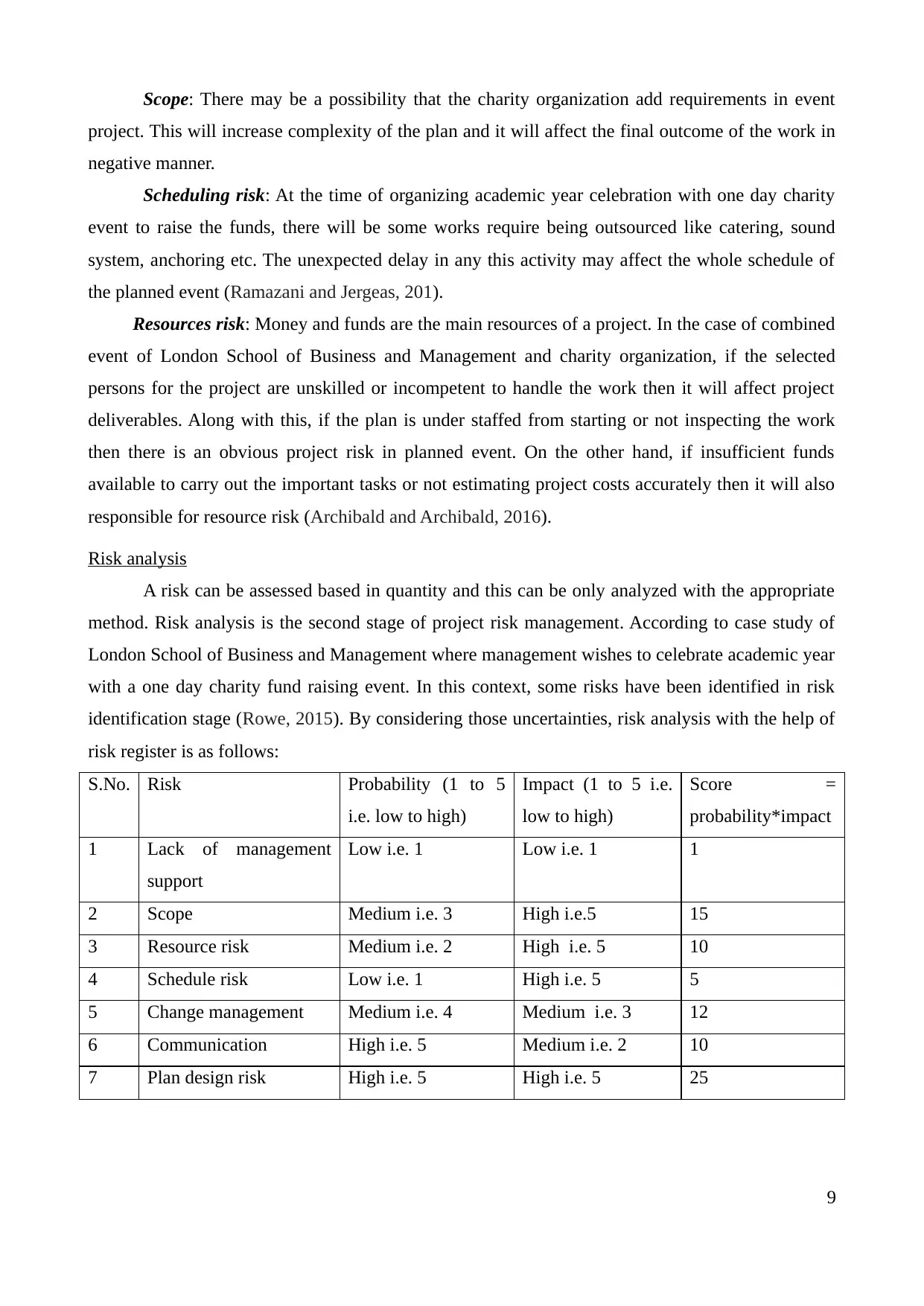
Scope: There may be a possibility that the charity organization add requirements in event
project. This will increase complexity of the plan and it will affect the final outcome of the work in
negative manner.
Scheduling risk: At the time of organizing academic year celebration with one day charity
event to raise the funds, there will be some works require being outsourced like catering, sound
system, anchoring etc. The unexpected delay in any this activity may affect the whole schedule of
the planned event (Ramazani and Jergeas, 201).
Resources risk: Money and funds are the main resources of a project. In the case of combined
event of London School of Business and Management and charity organization, if the selected
persons for the project are unskilled or incompetent to handle the work then it will affect project
deliverables. Along with this, if the plan is under staffed from starting or not inspecting the work
then there is an obvious project risk in planned event. On the other hand, if insufficient funds
available to carry out the important tasks or not estimating project costs accurately then it will also
responsible for resource risk (Archibald and Archibald, 2016).
Risk analysis
A risk can be assessed based in quantity and this can be only analyzed with the appropriate
method. Risk analysis is the second stage of project risk management. According to case study of
London School of Business and Management where management wishes to celebrate academic year
with a one day charity fund raising event. In this context, some risks have been identified in risk
identification stage (Rowe, 2015). By considering those uncertainties, risk analysis with the help of
risk register is as follows:
S.No. Risk Probability (1 to 5
i.e. low to high)
Impact (1 to 5 i.e.
low to high)
Score =
probability*impact
1 Lack of management
support
Low i.e. 1 Low i.e. 1 1
2 Scope Medium i.e. 3 High i.e.5 15
3 Resource risk Medium i.e. 2 High i.e. 5 10
4 Schedule risk Low i.e. 1 High i.e. 5 5
5 Change management Medium i.e. 4 Medium i.e. 3 12
6 Communication High i.e. 5 Medium i.e. 2 10
7 Plan design risk High i.e. 5 High i.e. 5 25
9
project. This will increase complexity of the plan and it will affect the final outcome of the work in
negative manner.
Scheduling risk: At the time of organizing academic year celebration with one day charity
event to raise the funds, there will be some works require being outsourced like catering, sound
system, anchoring etc. The unexpected delay in any this activity may affect the whole schedule of
the planned event (Ramazani and Jergeas, 201).
Resources risk: Money and funds are the main resources of a project. In the case of combined
event of London School of Business and Management and charity organization, if the selected
persons for the project are unskilled or incompetent to handle the work then it will affect project
deliverables. Along with this, if the plan is under staffed from starting or not inspecting the work
then there is an obvious project risk in planned event. On the other hand, if insufficient funds
available to carry out the important tasks or not estimating project costs accurately then it will also
responsible for resource risk (Archibald and Archibald, 2016).
Risk analysis
A risk can be assessed based in quantity and this can be only analyzed with the appropriate
method. Risk analysis is the second stage of project risk management. According to case study of
London School of Business and Management where management wishes to celebrate academic year
with a one day charity fund raising event. In this context, some risks have been identified in risk
identification stage (Rowe, 2015). By considering those uncertainties, risk analysis with the help of
risk register is as follows:
S.No. Risk Probability (1 to 5
i.e. low to high)
Impact (1 to 5 i.e.
low to high)
Score =
probability*impact
1 Lack of management
support
Low i.e. 1 Low i.e. 1 1
2 Scope Medium i.e. 3 High i.e.5 15
3 Resource risk Medium i.e. 2 High i.e. 5 10
4 Schedule risk Low i.e. 1 High i.e. 5 5
5 Change management Medium i.e. 4 Medium i.e. 3 12
6 Communication High i.e. 5 Medium i.e. 2 10
7 Plan design risk High i.e. 5 High i.e. 5 25
9
⊘ This is a preview!⊘
Do you want full access?
Subscribe today to unlock all pages.

Trusted by 1+ million students worldwide
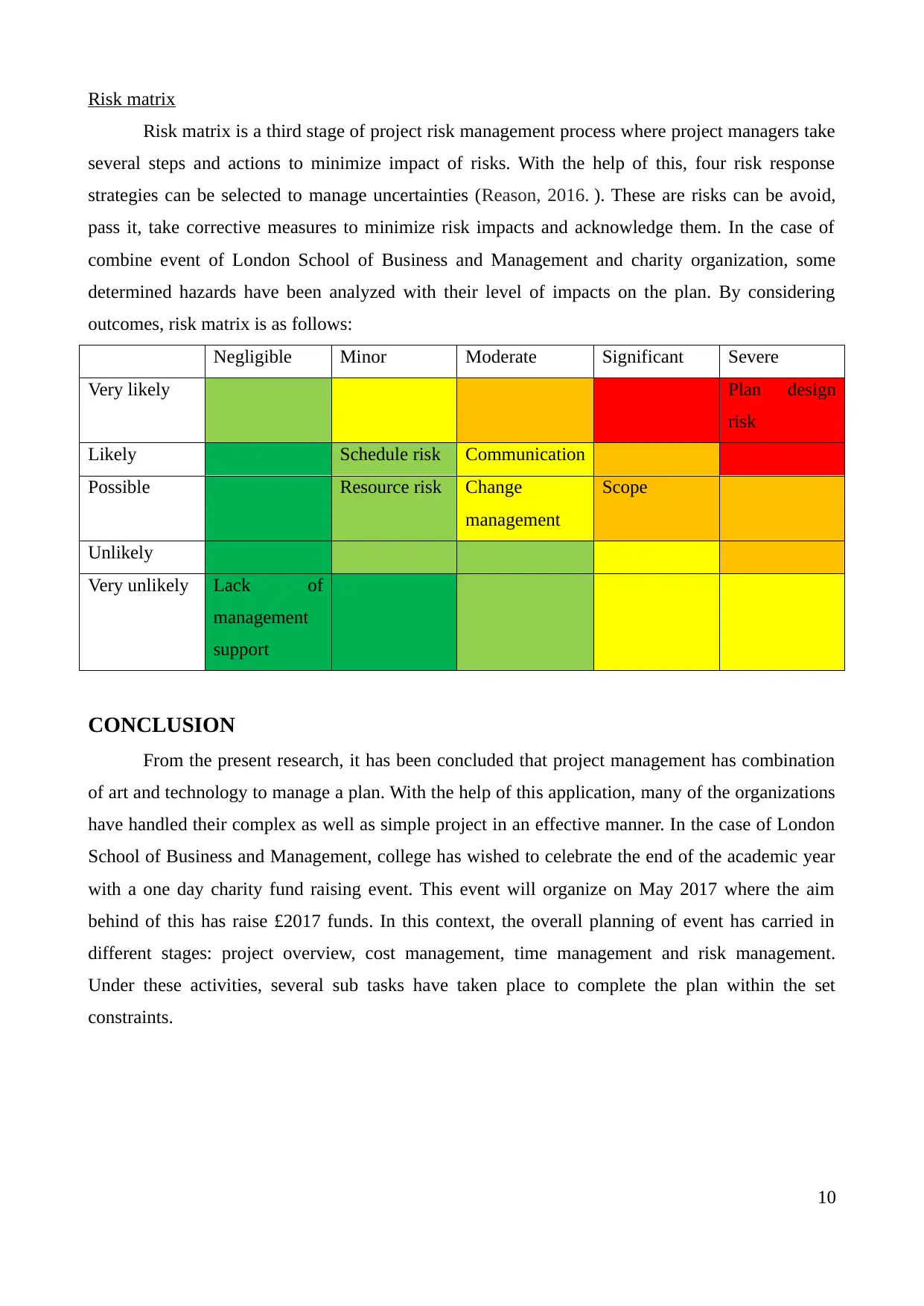
Risk matrix
Risk matrix is a third stage of project risk management process where project managers take
several steps and actions to minimize impact of risks. With the help of this, four risk response
strategies can be selected to manage uncertainties (Reason, 2016. ). These are risks can be avoid,
pass it, take corrective measures to minimize risk impacts and acknowledge them. In the case of
combine event of London School of Business and Management and charity organization, some
determined hazards have been analyzed with their level of impacts on the plan. By considering
outcomes, risk matrix is as follows:
Negligible Minor Moderate Significant Severe
Very likely Plan design
risk
Likely Schedule risk Communication
Possible Resource risk Change
management
Scope
Unlikely
Very unlikely Lack of
management
support
CONCLUSION
From the present research, it has been concluded that project management has combination
of art and technology to manage a plan. With the help of this application, many of the organizations
have handled their complex as well as simple project in an effective manner. In the case of London
School of Business and Management, college has wished to celebrate the end of the academic year
with a one day charity fund raising event. This event will organize on May 2017 where the aim
behind of this has raise £2017 funds. In this context, the overall planning of event has carried in
different stages: project overview, cost management, time management and risk management.
Under these activities, several sub tasks have taken place to complete the plan within the set
constraints.
10
Risk matrix is a third stage of project risk management process where project managers take
several steps and actions to minimize impact of risks. With the help of this, four risk response
strategies can be selected to manage uncertainties (Reason, 2016. ). These are risks can be avoid,
pass it, take corrective measures to minimize risk impacts and acknowledge them. In the case of
combine event of London School of Business and Management and charity organization, some
determined hazards have been analyzed with their level of impacts on the plan. By considering
outcomes, risk matrix is as follows:
Negligible Minor Moderate Significant Severe
Very likely Plan design
risk
Likely Schedule risk Communication
Possible Resource risk Change
management
Scope
Unlikely
Very unlikely Lack of
management
support
CONCLUSION
From the present research, it has been concluded that project management has combination
of art and technology to manage a plan. With the help of this application, many of the organizations
have handled their complex as well as simple project in an effective manner. In the case of London
School of Business and Management, college has wished to celebrate the end of the academic year
with a one day charity fund raising event. This event will organize on May 2017 where the aim
behind of this has raise £2017 funds. In this context, the overall planning of event has carried in
different stages: project overview, cost management, time management and risk management.
Under these activities, several sub tasks have taken place to complete the plan within the set
constraints.
10
Paraphrase This Document
Need a fresh take? Get an instant paraphrase of this document with our AI Paraphraser
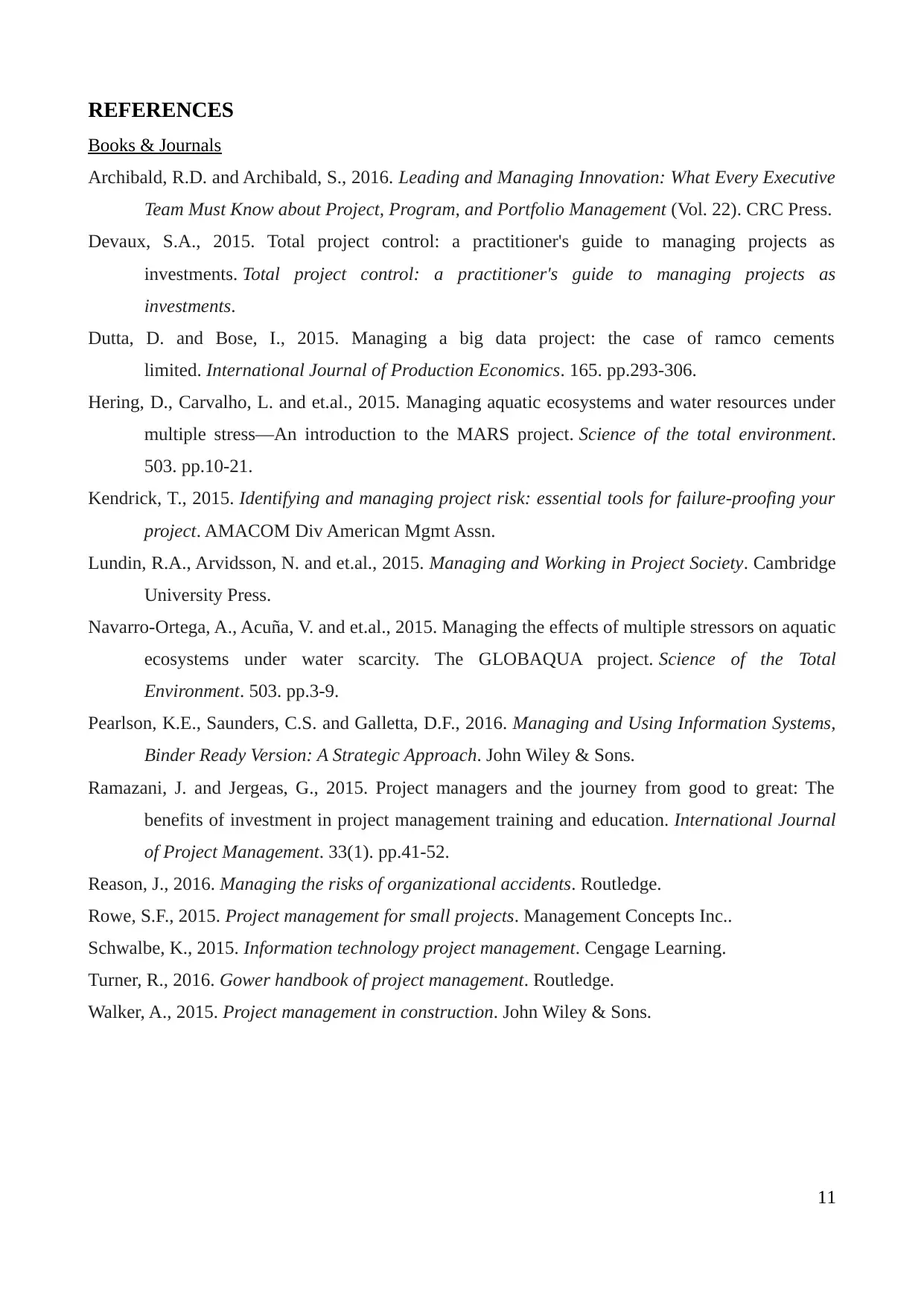
REFERENCES
Books & Journals
Archibald, R.D. and Archibald, S., 2016. Leading and Managing Innovation: What Every Executive
Team Must Know about Project, Program, and Portfolio Management (Vol. 22). CRC Press.
Devaux, S.A., 2015. Total project control: a practitioner's guide to managing projects as
investments. Total project control: a practitioner's guide to managing projects as
investments.
Dutta, D. and Bose, I., 2015. Managing a big data project: the case of ramco cements
limited. International Journal of Production Economics. 165. pp.293-306.
Hering, D., Carvalho, L. and et.al., 2015. Managing aquatic ecosystems and water resources under
multiple stress—An introduction to the MARS project. Science of the total environment.
503. pp.10-21.
Kendrick, T., 2015. Identifying and managing project risk: essential tools for failure-proofing your
project. AMACOM Div American Mgmt Assn.
Lundin, R.A., Arvidsson, N. and et.al., 2015. Managing and Working in Project Society. Cambridge
University Press.
Navarro-Ortega, A., Acuña, V. and et.al., 2015. Managing the effects of multiple stressors on aquatic
ecosystems under water scarcity. The GLOBAQUA project. Science of the Total
Environment. 503. pp.3-9.
Pearlson, K.E., Saunders, C.S. and Galletta, D.F., 2016. Managing and Using Information Systems,
Binder Ready Version: A Strategic Approach. John Wiley & Sons.
Ramazani, J. and Jergeas, G., 2015. Project managers and the journey from good to great: The
benefits of investment in project management training and education. International Journal
of Project Management. 33(1). pp.41-52.
Reason, J., 2016. Managing the risks of organizational accidents. Routledge.
Rowe, S.F., 2015. Project management for small projects. Management Concepts Inc..
Schwalbe, K., 2015. Information technology project management. Cengage Learning.
Turner, R., 2016. Gower handbook of project management. Routledge.
Walker, A., 2015. Project management in construction. John Wiley & Sons.
11
Books & Journals
Archibald, R.D. and Archibald, S., 2016. Leading and Managing Innovation: What Every Executive
Team Must Know about Project, Program, and Portfolio Management (Vol. 22). CRC Press.
Devaux, S.A., 2015. Total project control: a practitioner's guide to managing projects as
investments. Total project control: a practitioner's guide to managing projects as
investments.
Dutta, D. and Bose, I., 2015. Managing a big data project: the case of ramco cements
limited. International Journal of Production Economics. 165. pp.293-306.
Hering, D., Carvalho, L. and et.al., 2015. Managing aquatic ecosystems and water resources under
multiple stress—An introduction to the MARS project. Science of the total environment.
503. pp.10-21.
Kendrick, T., 2015. Identifying and managing project risk: essential tools for failure-proofing your
project. AMACOM Div American Mgmt Assn.
Lundin, R.A., Arvidsson, N. and et.al., 2015. Managing and Working in Project Society. Cambridge
University Press.
Navarro-Ortega, A., Acuña, V. and et.al., 2015. Managing the effects of multiple stressors on aquatic
ecosystems under water scarcity. The GLOBAQUA project. Science of the Total
Environment. 503. pp.3-9.
Pearlson, K.E., Saunders, C.S. and Galletta, D.F., 2016. Managing and Using Information Systems,
Binder Ready Version: A Strategic Approach. John Wiley & Sons.
Ramazani, J. and Jergeas, G., 2015. Project managers and the journey from good to great: The
benefits of investment in project management training and education. International Journal
of Project Management. 33(1). pp.41-52.
Reason, J., 2016. Managing the risks of organizational accidents. Routledge.
Rowe, S.F., 2015. Project management for small projects. Management Concepts Inc..
Schwalbe, K., 2015. Information technology project management. Cengage Learning.
Turner, R., 2016. Gower handbook of project management. Routledge.
Walker, A., 2015. Project management in construction. John Wiley & Sons.
11

12
⊘ This is a preview!⊘
Do you want full access?
Subscribe today to unlock all pages.

Trusted by 1+ million students worldwide
1 out of 12
Related Documents
Your All-in-One AI-Powered Toolkit for Academic Success.
+13062052269
info@desklib.com
Available 24*7 on WhatsApp / Email
![[object Object]](/_next/static/media/star-bottom.7253800d.svg)
Unlock your academic potential
Copyright © 2020–2025 A2Z Services. All Rights Reserved. Developed and managed by ZUCOL.




